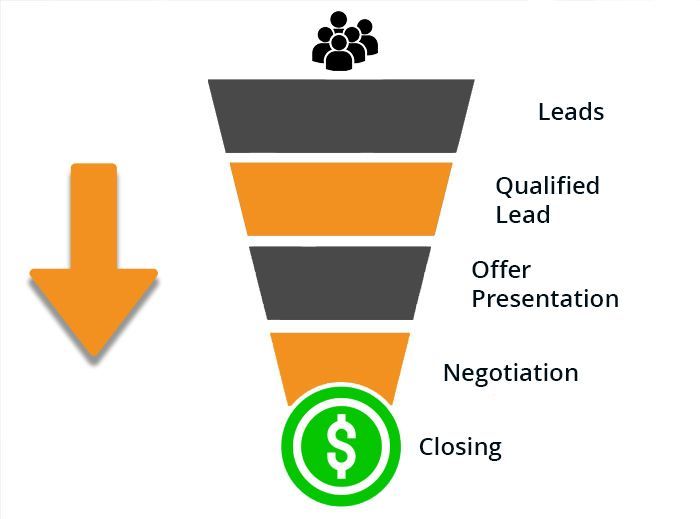
Sales Funnel in the Real Estate Industry - How Does It Work?
...
Discover the 6 secrets of real estate sales psychology and understand how it affects customer decisions. Learn key strategies that will help you run your real estate business more effectively. Get ready for a revolution in your sales approach!
Real estate is an arena of fierce competition for customers. With increasing competition and an abundance of offers on the market, the key to success is to understand the psychology behind buying decisions.
Customers are driven by emotions, desires and fears, often unconscious. It is these psychological factors that determine the final choice. That's why real estate developers and agents that can properly exploit psychological mechanisms gain an advantage.
In today's post, we will look at 6 proven strategies to influence the subconscious of customers. You will learn concrete ways to translate psychological theory into practical marketing activities.
We invite you to read on and wish you fruitful implementation of your new strategies!

The first step to successfully selling real estate is to understand the customer's psychology. Buying a property is usually one of life's most important decisions, so emotions play a key role.
Customers are not just looking for material aspects such as square footage or furnishings - they want a place with which they can build a deep bond. A home that will be an asylum and a refuge.
Therefore, showing this emotional potential is crucial. It is worth weaving colorful stories related to the property, telling about the previous residents and their fates. You can also emphasize the unique atmosphere of the house, an aura of mystery or stylish, atmospheric decor.
Equally important are the assets of the surroundings - the charming views outside the window, the nearby park or the neighbors' colorful gardens. All this builds emotional connection and positive associations. The more we stimulate customers' imagination and creativity, the easier it will be for them to imagine living in their new home and make a purchase decision.
However, let's remember to be gentle. Let's not force an emotional connection, but gradually build it with stories, descriptions and images. Selling real estate is ultimately a game of trust and winning the hearts of customers.

A picture is worth more than a thousand words - especially in the context of real estate. Customers want not only to see, but also to feel a potential home. That's why hitting their imagination and emotions with immersive photorealistic 3D visualizations is key.
Let's invest in high-quality photos, finishing details and stylish interior design. Let's show the property in the best light, but without exaggeration - authenticity is important. Virtual tour of a home can also make a big difference. Thanks to special 360-degree technologies, customers can almost physically move into the interiors and feel their atmosphere.
Importantly, visualizations work best when they are personalized for a specific client. For example, a family with children is more likely to imagine living in a new home when they see a children's room decorated according to their tastes. It's therefore a good idea to ask customers about their preferences in order to accurately tailor the property's image to their needs and dreams.

Human nature likes herdiness - we often follow the crowd. The same is true when buying real estate, where we suggest the opinions of others.
Therefore, it is crucial in marketing to present social proof in the form of testimonials from satisfied customers. Their stories, statements and photos are extremely convincing to potential buyers. They show the authentic emotions and experiences of people who have already decided to buy.
What's more, testimonials build trust in the brand and product. Since others were satisfied, it's a sign that the company is reliably delivering on its promises. Thus, the likelihood that subsequent customers will also be delighted increases.
That's why it's a good idea to take care of reviews, testimonials or videos from previous buyers. The more positive testimonials, the easier it is to convince the next ones. After all, people like to follow proven paths set by others.

Price is not just a number, but a psychological signal. Therefore, pricing strategy is crucial in real estate marketing.
One of the more effective tactics is to use price-prestige, that is, to slightly inflate the amount in order to emphasize the exclusivity and uniqueness of the offer. Customers looking for luxury and status are more likely to invest in a property perceived as premium. A higher price may even encourage them to buy.
However, this amount should be justified by additional values - such as amenities, design and unique features. Limited promotions or special offers that create the appearance of a bargain and encourage a quick decision are also a good idea.
Remember, a prestigious price requires a prestigious setting - from marketing materials to customer service. The entire experience must be consistent and fit into the higher end for the strategy to succeed.

Buying decisions are driven by emotion, not logic. Therefore, let's build emotional stories around the offer, not just dry facts.
Let's tell an interesting story about the previous owners and their life in the property. Let's show pictures of happy moments of the residents. Let's emphasize the unique atmosphere and ambience there. The more engaging the story, the better.
If you're a developer, it's worth taking care of the unique character of the development already at the design stage. Let's create a consistent vision, atmosphere and style that can be communicated in marketing. References to local traditions, culture or architecture work well.
Equally important is the setting of the territory. Let's invest in small architecture, landscaping and common spaces. Let's create places conducive to building neighborhood ties like barbecue zones or playgrounds. The more opportunities for positive experiences, the better.
The customer likes to feel special. Therefore, the key to success is a personalized approach that fits in with his specific needs and desires.
Take the time to deeply understand the customer's priorities. Does he dream of a modern or traditional interior? Does he prefer a park view or proximity to his children's school? Does he collect artwork or prioritize convenience?
Then let's tailor the real estate offer to these individual preferences. Let's show that we understand who the client is and what he or she is really looking for. It's also good to probe and make sure our understanding is correct.
This personalized approach makes the customer feel like a VIP. He knows that he is not just a number in a database, but an individual with his unique tastes. Such a bond increases trust and the chances of finalizing a transaction. Because the customer likes to feel special.
Selling real estate is a game of emotions and trust. That's why it's crucial to have a deep understanding of clients - their dreams, fears and desires. Only then can we tailor our offer to their individual needs.
So let's tell engaging stories related to the property and build an emotional connection with potential buyers. Let's show authentic feedback from satisfied customers to inspire trust. Let's invest in immersive visuals to help them imagine life in their new home.
The better we tap into the emotional needs of customers, the better the chances of success. Because in the world of real estate, it's not just hard data that counts, but also soft factors. And the latter often determine purchasing decisions.
Therefore, let's get to know our customers and build a relationship with them. Only then can we count on long-term partnerships and mutual benefits. And this is the key to prosperity in this demanding business.
Book a free consultation.
Sign up now for our free RendProletter and receive 1 email every week with a short summary of the best posts from our blog and emails with unique offers you won't find anywhere else!